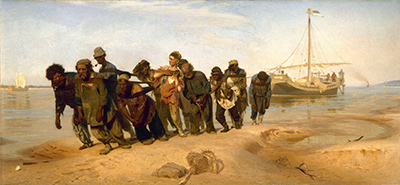Barge Haulers on the Volga, painted by Russian-Ukrainian artist Ilya Repin between 1870 and 1873, depicts a team of eleven men struggling to haul a barge along the water from the riverbank.
The burlaks, typically landless peasants who hauled barges on the Russian Empire's rivers, are dressed in rags and harnessed to the towing rope by leather straps worn tight across their chests. These harnesses, against which one beardless young man seems to struggle, give the labourers the impression of animals under the yoke. Repin, an alumni of the Imperial Academy of Arts in Saint Petersburg who strove to depict social realism in his artworks, based the figures featured in the oil-on-canvas painting upon a group of barge haulers that he had known during his travels in the Volga region.
A steamboat appears as a distant figure on the horizon, visible on the left-hand side of the canvas with a plume of dark smoke rising from its smokestack, and indicates the technological era in which the painting is set. The juxtaposition of human labour and mechanical propulsion draws attention to the decline of the burlaks during the Industrial Revolution as their physical strength is rendered obsolete by the power of machines. Hauling barges, although strenuous and physically exhausting, was how many working people in the Volga region made their living and burlaks may have struggled to adapt to an environment in which steam-engines deprived them of employment.
A large portion of Western Russia is drained out to sea via the River Volga which means that any watercraft travelling inland must do so in opposition to strong river currents. The heroic struggle of the burlaks, pitching their strength against the relentless flow of water, could represent a progressive momentum in Russia that contends with forces that wish to maintain the status quo or revert society to a previous state of affairs. One of two figures on-board the barge is seen using the tiller to steer the stern-mounted rudder, the manoeuvring of the barge being a possible reference to steering the ship of state, while the other figure stands with his back to the helmsman and observes the burlaks labouring on the shore.
The 1870s, when the painting was researched and created, was a time of social change in Russia that was due to the reformist policies of the reigning Tsar Alexander II and to modernising influences from abroad. Serfdom, abolished via the Emancipation Reform act of 1861, was still a recent memory in Russia and social inequality remained a central feature of day-to-day life in the Empire. The site of the burlaks, although selling their labour for financial compensation, hauling the heavy barge in the manner of beasts-of-burden is reminiscent of the forced-labour characteristic of the feudal system. The harsh working conditions of the burlaks depicted in the painting stood in stark contrast to the comfortable lifestyles enjoyed by the landed nobility.
Grand Duke Vladimir Alexandrovich bought the painting, despite its depiction of the plight of the working poor, and housed it his Saint Petersburg residence known as the Vladimir Palace. The painting, which received critical acclaim for the finery of its execution and social criticism, won a bronze medal when it was exhibited at the 1873 International Exhibition at Vienna and was often cited as a prime example of the Realism style that had emerged from the Russian academies. After the October Revolution of 1917 the painting, now considered to be the property of the Russian people, was relocated to the Russian Museum of fine art in Saint Petersburg where it was displayed to the general public.




